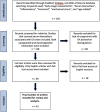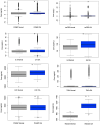A Review and Meta-Analysis of Biomarkers in Early-Stage Osteoarthritis
- PMID: 40376723
- PMCID: PMC12214422
- DOI: 10.1111/os.70064
A Review and Meta-Analysis of Biomarkers in Early-Stage Osteoarthritis
Abstract
Osteoarthritis (OA) is a common musculoskeletal disorder impacting millions in the United States, presenting with joint pain, stiffness, and reduced mobility. Its complex origins and lack of clear early-stage symptoms make early detection challenging. Traditional diagnostic methods, including imaging, are often used when significant cartilage loss has already occurred. However, serum biomarkers offer potential for earlier and less invasive detection. For our review, articles published from 1980 to 2024 that analyzed OA serum biomarkers were retrieved from PubMed, Embase, and Web of Science. The analysis included biomarker frequency, percent changes from baseline levels, and logistic regression to assess correlations with OA. Several biomarkers exhibited altered levels in OA, classified into inflammatory, collagenous, mechanical stress, and other categories. Inflammatory markers such as IL-6 and MPO showed significant elevation, while TNF-α showed minimal correlation with OA. Collagenous markers, especially COMP, were consistently elevated in patients, correlating with disease severity. Additionally, PIIANP showed a strong negative correlation with OA progression. Obesity-related markers, including resistin, were also associated with OA, and logistic regression confirmed IL-6, COMP, and resistin as strongly correlated with OA, with PIIANP demonstrating a significant inverse relationship. This review highlights the critical role of serum biomarkers in OA detection and progression. Markers like IL-6, COMP, and PIIANP offer significant potential for early diagnosis. Integrating these biomarkers into clinical practice may facilitate earlier intervention, potentially slowing OA progression. Future research should focus on validating these findings across larger, diverse populations and refining therapeutic strategies targeting these biomarker pathways.
Keywords: biomarkers; detection; early‐stage; osteoarthritis; serum.
© 2025 The Author(s). Orthopaedic Surgery published by Tianjin Hospital and John Wiley & Sons Australia, Ltd.
Conflict of interest statement
The authors declare no conflicts of interest.
Figures






Similar articles
-
WITHDRAWN: Low level laser therapy (Classes III) for treating osteoarthritis.Cochrane Database Syst Rev. 2007 Jul 18;(1):CD002046. doi: 10.1002/14651858.CD002046.pub3. Cochrane Database Syst Rev. 2007. PMID: 17636694
-
Diacerein for osteoarthritis.Cochrane Database Syst Rev. 2014 Feb 10;2014(2):CD005117. doi: 10.1002/14651858.CD005117.pub3. Cochrane Database Syst Rev. 2014. PMID: 24515444 Free PMC article.
-
Utilizing metabolomics to identify potential biomarkers and perturbed metabolic pathways in osteoarthritis: A systematic review.Semin Arthritis Rheum. 2023 Apr;59:152163. doi: 10.1016/j.semarthrit.2023.152163. Epub 2023 Jan 13. Semin Arthritis Rheum. 2023. PMID: 36736024 Free PMC article.
-
Systemic pharmacological treatments for chronic plaque psoriasis: a network meta-analysis.Cochrane Database Syst Rev. 2021 Apr 19;4(4):CD011535. doi: 10.1002/14651858.CD011535.pub4. Cochrane Database Syst Rev. 2021. Update in: Cochrane Database Syst Rev. 2022 May 23;5:CD011535. doi: 10.1002/14651858.CD011535.pub5. PMID: 33871055 Free PMC article. Updated.
-
Osteoarthritis in cats: what we know, and mostly, what we don't know. . . yet.J Feline Med Surg. 2025 Jul;27(7):1098612X251347999. doi: 10.1177/1098612X251347999. Epub 2025 Jul 20. J Feline Med Surg. 2025. PMID: 40685570 Free PMC article. Review.
Cited by
-
Integrated Bioinformatics and Experimental Validation Reveal Macrophage Polarization-Related Biomarkers for Osteoarthritis Diagnosis.J Multidiscip Healthc. 2025 Aug 1;18:4589-4612. doi: 10.2147/JMDH.S537507. eCollection 2025. J Multidiscip Healthc. 2025. PMID: 40765736 Free PMC article.
References
-
- Sinusas K., “OA: Diagnosis and Treatment,” American Family Physician 85, no. 1 (2012): 49–56. - PubMed
Publication types
MeSH terms
Substances
LinkOut - more resources
Full Text Sources
Medical
Research Materials
Miscellaneous

